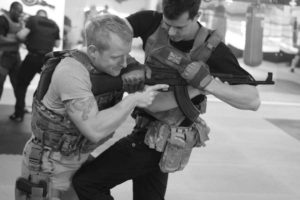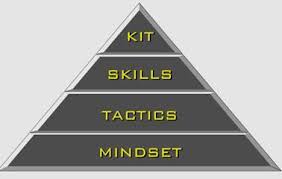The Vital Pyramid & Combative Protocol

John “Lofty” Wiseman of the Special Air Service introduced the concept of the Vital Pyramid, which has since been used as the content framework for combatives practice by several instructors. Strangely enough, despite being common knowledge in the combatives fraternity, it isn’t something that is readily enforced in regular British Military Units (From a specific combatives perspective not generic soldiering). Something I tried to get across in my time in the Royal Marines. The constant focus on peacekeeping type operations make the likelihood of close combat much more probable but severely paid lip service to. A discussion for another day.

The Pyramid is a hierarchy of components comprising of what is needed to survive a violent engagement. This goes for absolutely anyone! from the tier 1 operator to the civilian trying to get home safe.
What is a common argument by a lot of people who conduct no self defence training or discount it’s value is “I would just run” or “I would just shoot them” even worse is “That would never work” (In some cases this is correct) or “you cannot defend a knife so why train it?”
This type of mentality can have huge consequences. Firstly you are either misunderstanding the dynamics of violence or, training yourself into learned helplessness. This mind state can make the likelihood of freezing in a violent engagement increase when things do not go to plan.
Recently in my local area a woman was slashed with a knife in broad daylight with her child. On the local community groups the discussions were immediately awash with the type of self defence tool they should carry. Considering in the UK we are highly restricted legally to what you can and can’t carry. Also consider that even if you could or do carry a weapon (in other countries) can you guarantee you will be able to get to it?
In order to maximize success you must have understanding of the vital pyramid and it’s components, You will then be well rounded and able to adapt to most situations.
Mindset:
This is the foundation. You must have awareness, recognize body language, and understand reaction times to realistically deal with threats at varying distances. The ability to adapt & improvise. Adding to this is State Management & State access. State management is the ability to control you emotional state under stress. State access is the ability to access aggression and determination at a flick of switch. This is key. An excellent quote from Lee Morrision -Urban Combatives is “I will prevail! If I don’t I should survive” What this effectively means is you will do what ever it takes to win and if not you should survive. Rather than having the attitude of just trying to survive, it gives you somewhere to go with it and an elevated output.
“I will prevail! If I don’t I should survive” Lee Morrision – Urban Combatives
Tactics/Principle’s:
This is having an approach and understanding the generic dynamics of violence. It’s understanding that in pre-conflict situations you need to go first! If you go, you need to keep going until the threat is finished. Use gross motor movements, all the way in or all the way out! Always assume there is a weapon, always assume there is more than one attacker. This will give you the winning game plan from the start and is regularly enforced in my classes. This is far more important than the technical skills at the early stages.
Skills:
This is the technical breakdown of particular techniques and situation’s. How to punch properly, how to kick properly, how to defend edged weapon’s in particular situations, how to escape certain grabs and choke’s. As you can see this area can go really into depth. It’s pointless if the student doesn’t have a grasp of the principles. If things go wrong or they come across a situation they haven’t trained for and are unable to adapt they will fall apart.
“I can give you a collection of key’s or I can teach you to become a key maker” – Todd Fossey Integrative Defense Strategies
Kit/Gear/Tools:
The final part of the pyramid and the cherry on top. In simple terms if you have the mindset to fight and use aggression when needed, understand principles and have the unarmed skills, kit is a bonus! You will be much better placed to use the taser, baton, firearm or self defence tool at the right time rather than relying on it. It all comes down to the fact do you have a tool and can you get to it? If not you have a backup plan!
Its important to note however that the vital pyramid represents the correct training methodology. In real violence yes getting to a weapon is your priority if you have one. The Krav Maga/Combative protocol is as follows:
Before an attack
- Avoidance
- Pre-emptive action
- Compliance if appropriate and if it will maximize safety.
During an attack:
- Use of weapons or improvised tools (Chairs, bags, umbrellas etc…)
- Long range skills (Kicks, immediate disengage options to escape and/or get to a weapon)
- Short range skills: (clinching and extreme close quarters skills)
- Disarms: (Absolute last priority depending on circumstances. Also assume multiple attackers and if you can realistically take the weapon, do you need to?)
